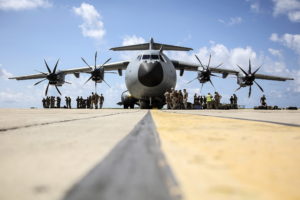
LONDON – The Royal Air Force is upgrading its approach to flight data monitoring (FDM) and analysis for its fleet of Airbus A400M, through the use of Teledyne Controls’ AirFASE and flight data analysis (FDA+) modules to capture and identify trends about the aircraft’s engines and other critical components.
A400M aircraft first started entering service for RAF in 2014, and has grown to a fleet of 20 aircraft with the full fleet size expected to reach 22 by the early 2020s as a fleet replacement to the C-130J Hercules fleet. Used by RAF as a strategic lift and tactical air transport aircraft, the AirFASE and FDA+ technologies were procured by the U.K. Ministry of Defense’s (MoD) Defense Equipment and Support (DE&S) team.
This marks the first purchase of new flight data monitoring technology by DE&S since the MoD published “Regulation RA1205,” which identifies as a safety case requirement for military aircraft types. AirFASE is flight data monitoring software developed by Airbus and Teledyne Controls that is capable of translating raw flight data into engineering values. As part of the back-end support functionality for the data-capturing and storage capability provided by AirFASE, Teledyne is using IBM [IBM] for its cloud computing needs and has expanded support of cloud-computing analysis and storage for operators.
Michael Wilkinson, who serves as officer in charge of FDM and the A400M training manager for RAF, said that their use of the technology will bring new benefits to maintenance, flight operations, training and safety.
“We are using AirFASE to monitor the engines so that we can see any trends from the normal limits and put in place solutions prior to the engine malfunctioning. For this we trend all four engines and monitor for one of the engines diverging from the other three’s parameters. In time we will modify and enhance this when we get more data from the aircraft – it is early days having only realized the capability this month,” Wilkinson said in an emailed statement.
According to Wilkinson, on the operations side, AirFASE will also provide the RAF’s “fuel monitoring cell” with fuel usage data at a much higher fidelity than they’re currently capable of. It will also provide insights on fuel usage on specific routes and altitudes for flight planning. Data analysis capabilities from the new tools will also be used to supplement RAF’s existing safety management system and will provide Wilkinson with data that will optimize and lead to “informed changes” for A400M training.
“Prior to selecting AirFASE the RAF was collecting and storing all flight data to be used when a suitable contract was finalized. With the A400M now the lead platform in this field, it will shortly be followed by other RAF platforms. In the past, we have used FDM on platforms such as the Tristar and BAE 146, however, the contracts for these platforms expired, alongside the technology previously used. With AirFASe we are now able to re-energize this capability,” Wilkinson said.
RAF has become the latest military operator to acquire the FDM technology from Teledyne Controls following a recent deal for the technology by the Polish Air Force. However, Mark Collishaw, senior manager of military technical sales for Teledyne Controls, said the company has been supplying FDM technology to military operators for more than a decade.
As an example, Teledyne supplies similar support to the Australian Defense Force, Canadian Air Force, Netherlands Air Force, U.S. Air Force, U.S. Navy and U.S. Marine Corps to name a few. Collishaw said he has seen renewed interest on the defense side of their business in the technology.
“Conferences such as the SMi Defense Aviation Safety seminar are advocating flight data analysis/flight data monitoring to military aviation authorities, who are starting to accept that good usage of recorded flight data has an important part to play in increasing mission effectiveness and capability,” Collishaw said.
A major difference between the recent Polish Air Force deal for 737NG and RAF’s selection of AirFASE for the A400M is that the 737NG features Teledyne’s digital flight data unit as standard flight data acquisition equipment, whereas the A400M does not.
“Airbus Defense and Space has equipped its A400M aircraft with technologies from vendors other than Teledyne Controls. This underlines one of the strengths of AirFASE; that it can process recorded flight data from an array of data acquisition units, flight data recorders, quick access recorders and onboard servers from an array of vendors other than Teledyne,” Collishaw said.
This article was originally published in our sister publication Aviation Today.